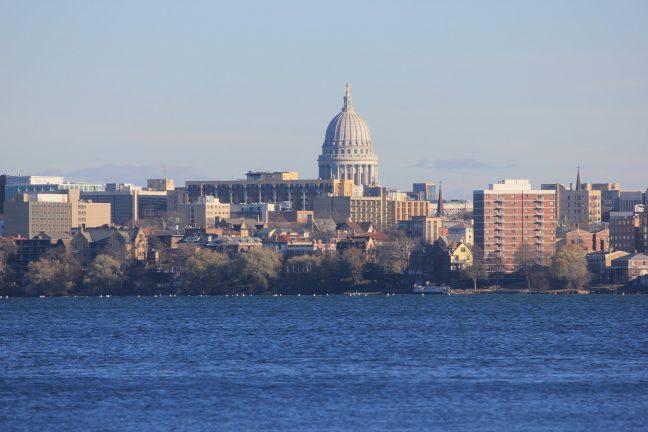Warmer weather, extreme precipitation and more flooding are expected for the Great Lakes region in the coming years, according to a new report from local scientists.
The report was commissioned by the Environmental Law & Policy Center and includes researchers from various universities. Among the researchers was Daniel Vimont, a University of Wisconsin atmospheric and oceanic sciences professor who serves as the director of the Nelson Institute Center for Climatic Research.
Vimont said the report confirms what scientists already knew.
“The fact that we have known about this [change] already and that this report — which is an update of this and reiterates the same thing — tells us were pretty confident in the changes that we’re experiencing,” Vimont said.
The report found the Great Lakes basin has warmed nearly two degrees in annual mean air temperature over the last century, which is higher than the rest of the contiguous U.S.
That trend isn’t expected to stop. The report estimates average global air temperatures will warm between three and seven degrees by the end of the 21st century.
The increased air temperature will lead to increased precipitation, as warmer air can hold more water, Vimont said. This means we can expect more extreme downpours in the next 30 years.
“We’ve known that intense precipitation events are likely to become more frequent, but in the last few years, we’ve started to realize that the really extreme events — these 500 year, unheard-of events — are likely to be even more strongly impacted than the 10-15 inch events,” Vimont said.
Additionally, Vimont said such warming will affect how the lake mixes, and could lead to the lake itself warming. With extreme rainfall creating runoff into the lake, the combined force of these events make for poor ecological conditions in the lake.
UW botany and environmental studies professor Don Waller said he is concerned about the plants in the Great Lakes area in particular.
“What really struck me is how many species are being affected and in many ways,” Waller said. “[We know] that most plant species are moving towards the northwest, and have already. But as climate changes accelerate, what we’re finding is that most plant species can’t keep up with the rate — they are falling behind.”
Waller said the average climate has changed by over 100 kilometers over the last 50 years, while the average species changes only 50 or 60 kilometers. This has created a mismatch in the climate, which is detrimental to plant species, Waller said.
Waller is also concerned about aberrant changes in animal populations. Some species are facing extinction because of the extreme changes, while other populations are booming.
Because of limited hunting, improved habitats, plenty of available food and milder winters, the whitetail deer population is thriving. However, Waller said this has limited the ability of many tree species to regenerate across Wisconsin.
Waller also expressed concern over agriculture, as it is a basis for the Midwest’s economy. Waller said farmers across Wisconsin and other states are already being affected by the recent record rain events.
“The problem for farmers is that spring flooding in particular means they can’t plant their crops when they want to,” Waller said. “Delaying planting means their crops are going to be growing later into the season, when the droughts may hit them. It’s kind of like a double whammy.”
Jonathan Patz, the director of the UW Global Health Institute, said extreme heat is also a cause for concern.
As a midwestern city, Patz said Madison is susceptible to heat waves — which, according to the new report, will increase threefold in coming years.
“People die in heat waves,” Patz said. “We’ve actually done a study in Milwaukee, and during a heat wave, you get increased admission for heart disease, lung diseases, kidney diseases from dehydration, increased issues with diabetes and, surprisingly, attempted suicide.”
Patz said for these reasons, and the fact that some people don’t have access to a cooling center, heat waves are one of the biggest problems associated with climate change.
Patz is also concerned about the increase in flooding incidents, which decrease water quality.
“With floods, you’ve got the infrastructural damage, but water quality is also affected,” Patz said. “We’ve done studies in the central part of [Wisconsin] that shows an increase in childhood admissions for gastrointestinal disease related to heavy rainfall events.”
Patz said a newer problem in Wisconsin is the contamination from Concentrated Animal Feeding Operations. When there is flooding near CAFOs with containment ponds of hog waste, it can lead to contamination issues through runoff into lakes and streams.
Another problem is air pollution, Patz said. Ground-level smog ozone is increased in warmer temperatures and is unhealthy for asthmatics.
While these are all concerns to take into account, Vimont said it is most important for communities to begin buffering themselves against climate change’s impacts.
Vimont said even if global carbon emissions are reduced by a massive amount, an inevitable amount of change will still occur.
For Vimont, that requires conversations between scientists, businesses, community members and government organizations — the Wisconsin Idea in action. The best thing we can be doing now, he said, is to communicate the information and identify how to work together to build resilience against what is inevitably coming.
Vimont said he is especially focused on the Great Lakes, as they are a unique resource that need to be saved.
“The Great Lakes are an amazing national resource. They are iconic,” Vimont said. “There’s 34 million people that live in the Great Lakes basin, there’s billions of dollars worth of industry generated by the Great Lakes — they are like the rocky mountains, something that everybody recognizes. And we need to be thinking of it as a national treasure and we need to be working to try to build resilience in the lakes and the communities that rely on them.”


